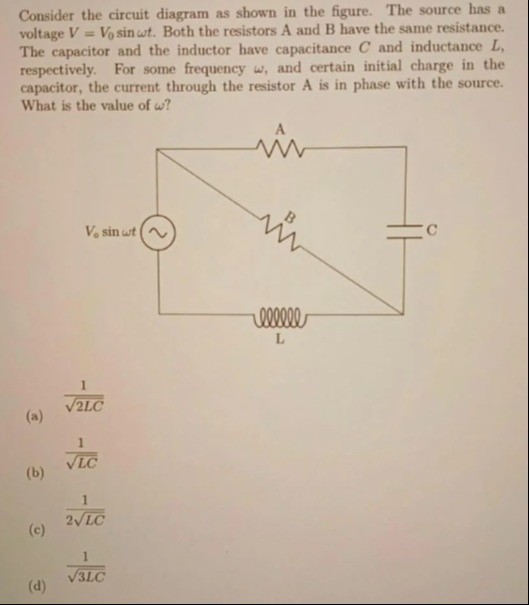Question
Question: Consider the circuit diagram as shown in the figure. The source has a voltage \(V = V_0 \sin \omega ...
Consider the circuit diagram as shown in the figure. The source has a voltage V=V0sinωt. Both the resistors A and B have the same resistance. The capacitor and the inductor have capacitance C and inductance L, respectively. For some frequency ω, and certain initial charge in the capacitor, the current through the resistor A is in phase with the source. What is the value of ω?

2LC1
LC1
2LC1
3LC1
ω=2LC1
Solution
To find the frequency ω at which the current through resistor A is in phase with the source voltage, we need to analyze the circuit's impedance. The key is to ensure that the imaginary part of the total admittance of the parallel branches (capacitor and resistor-inductor series) is zero. This condition makes the overall impedance purely real, leading to the current being in phase with the voltage.
Here's a breakdown of the solution:
-
Calculate Impedances:
- Impedance of the capacitor branch: Z1=jωC1
- Impedance of the resistor-inductor branch: Z2=R+jωL
-
Calculate Admittances:
- Admittance of the capacitor branch: Y1=jωC
- Admittance of the resistor-inductor branch: Y2=R+jωL1=R2+ω2L2R−jωL
-
Total Admittance: The total admittance of the parallel branches is the sum of individual admittances:
Ytotal=Y1+Y2=jωC+R2+ω2L2R−jωL=R2+ω2L2R+j(ωC−R2+ω2L2ωL) -
In-Phase Condition: For the current to be in phase with the voltage, the imaginary part of the total admittance must be zero:
ωC−R2+ω2L2ωL=0 -
Solve for ω:
ωC=R2+ω2L2ωL C=R2+ω2L2L R2+ω2L2=CL -
Choose R for Frequency Independence: To make the frequency independent of the resistance R, we choose R2=2CL. Substituting this into the equation:
2CL+ω2L2=CL ω2L2=CL−2CL=2CL ω2=2LC1 ω=2LC1
Therefore, the value of ω for which the current through resistor A is in phase with the source is 2LC1.
